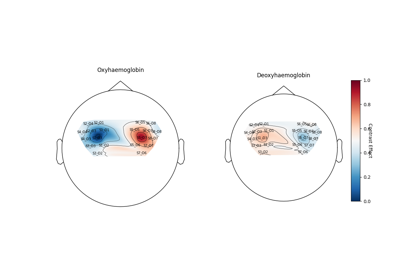mne_nirs.statistics.ContrastResults#
- class mne_nirs.statistics.ContrastResults(info, data, design)[source]#
Class containing GLM contrast results.
- Parameters:
- Attributes:
ch_namesReturn the channel names.
compensation_gradeThe current gradient compensation grade.
- data
Methods
copy()Return a copy of the GLM results.
get_channel_types([picks, unique, only_data_chs])Get a list of channel type for each channel.
plot_topo([figsize, sphere])Plot topomap GLM contrast data.
save(fname[, overwrite])Save GLM results to disk.
scatter([conditions, exclude_no_interest, ...])Scatter plot of the GLM results.
to_dataframe([order])Return a tidy dataframe representing the GLM results.
- Returns:
- glm_estResultsGLM,
Result class.
- __contains__(ch_type)#
Check channel type membership.
- Parameters:
- ch_type
str Channel type to check for. Can be e.g.
'meg','eeg','stim', etc.
- ch_type
- Returns:
- inbool
Whether or not the instance contains the given channel type.
Examples
Channel type membership can be tested as:
>>> 'meg' in inst True >>> 'seeg' in inst False
- __hash__ = None#
- property compensation_grade#
The current gradient compensation grade.
- copy()#
Return a copy of the GLM results.
- Returns:
- instinstance of ResultsGLM
A copy of the object.
- get_channel_types(picks=None, unique=False, only_data_chs=False)#
Get a list of channel type for each channel.
- Parameters:
- picks
str| array_like |slice|None Channels to include. Slices and lists of integers will be interpreted as channel indices. In lists, channel type strings (e.g.,
['meg', 'eeg']) will pick channels of those types, channel name strings (e.g.,['MEG0111', 'MEG2623']will pick the given channels. Can also be the string values'all'to pick all channels, or'data'to pick data channels. None (default) will pick all channels. Note that channels ininfo['bads']will be included if their names or indices are explicitly provided.- uniquebool
Whether to return only unique channel types. Default is
False.- only_data_chsbool
Whether to ignore non-data channels. Default is
False.
- picks
- Returns:
- channel_types
list The channel types.
- channel_types
- save(fname, overwrite=False)#
Save GLM results to disk.
- scatter(conditions=(), exclude_no_interest=True, axes=None, no_interest=None)#
Scatter plot of the GLM results.
- Parameters:
- conditions
list List of condition names to plot. By default plots all regressors of interest.
- exclude_no_interestbool
Exclude regressors of no interest from the figure.
- axesAxes
Optional axes on which to plot the data.
- no_interest
list List of regressors that are of no interest. If none are specified then conditions starting with [“drift”, “constant”, “short”, “Short”] will be excluded.
- conditions
- Returns:
- pltmatplotlib.Figure
Scatter plot.
- to_dataframe(order=None)#
Return a tidy dataframe representing the GLM results.
- Parameters:
- order
list Order in which the rows should be returned by channel name.
- order
- Returns:
- tidy
pandas.DataFrame Dataframe containing GLM results.
- tidy
